Managing Projects: A Report on Unilever's Project Sunlight Initiative
VerifiedAdded on 2023/01/13
|14
|4533
|77
Report
AI Summary
This report provides a comprehensive analysis of project management principles, using Unilever's Project Sunlight initiative as a case study. It begins with an introduction to projects and their role in delivering organizational strategy, emphasizing the importance of aligning projects with the organization's vision and mission. The report then delves into the project initiation process, including the creation of key documents like project charters, key performance indicators (KPIs), and resource requirements. It explores the impact of legal, organizational, and ethical factors on projects, such as the Equality Act and Corporate Social Responsibility. The report highlights various tools and techniques used in project management, including Gantt charts, work breakdown structures (WBS), and project methodologies like Total Quality Management and Waterfall methodology. It also examines techniques for working collaboratively with stakeholders, emphasizing the importance of identifying their needs and expectations. The report further discusses methods for monitoring project progress, reporting on project outcomes, and approaches for project closure. Finally, it addresses methods of managing data and information, problem-solving and decision-making techniques, and approaches to identify, manage, and mitigate project risks, providing a complete overview of the project management process within the context of Project Sunlight.
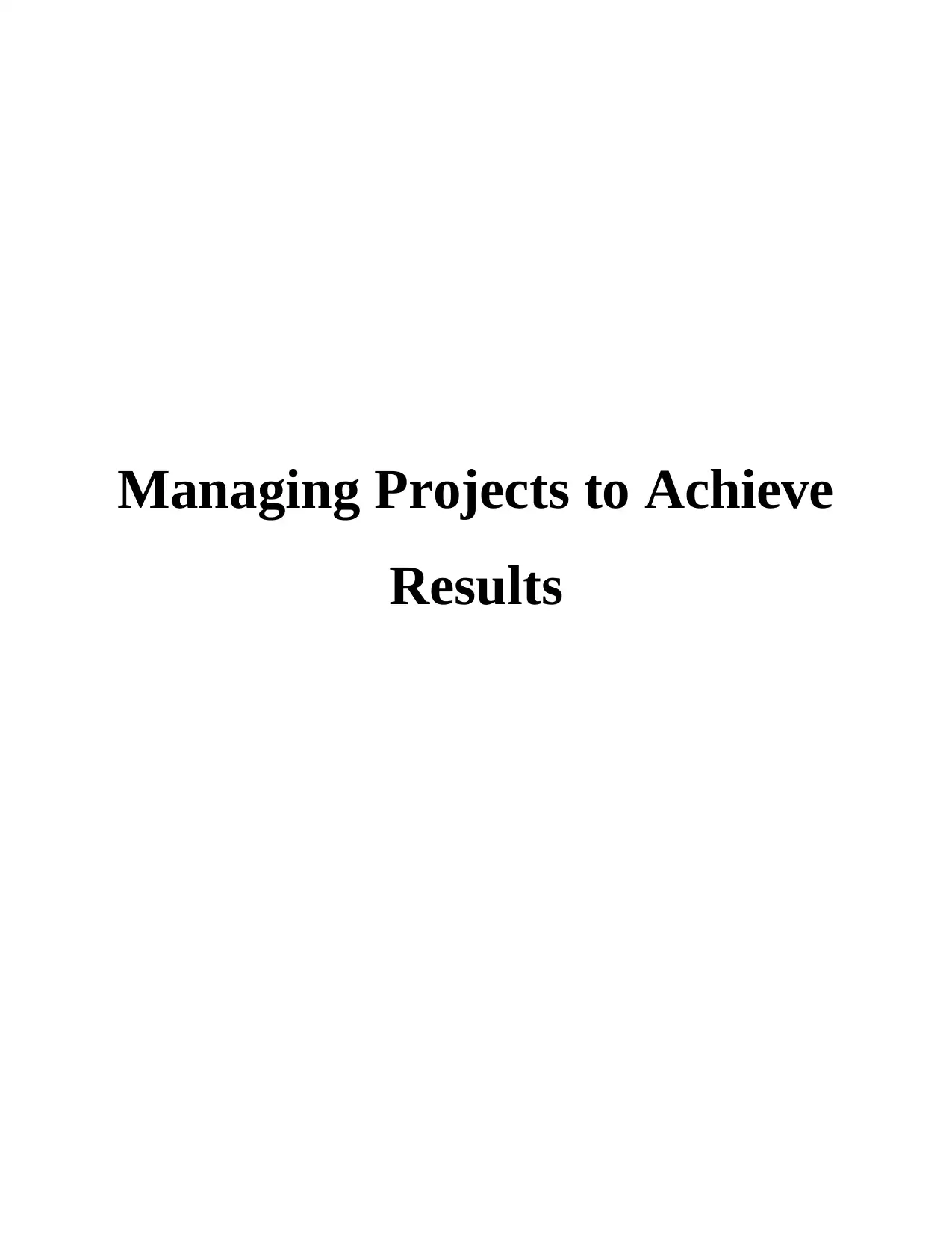
Managing Projects to Achieve
Results
Results
Paraphrase This Document
Need a fresh take? Get an instant paraphrase of this document with our AI Paraphraser
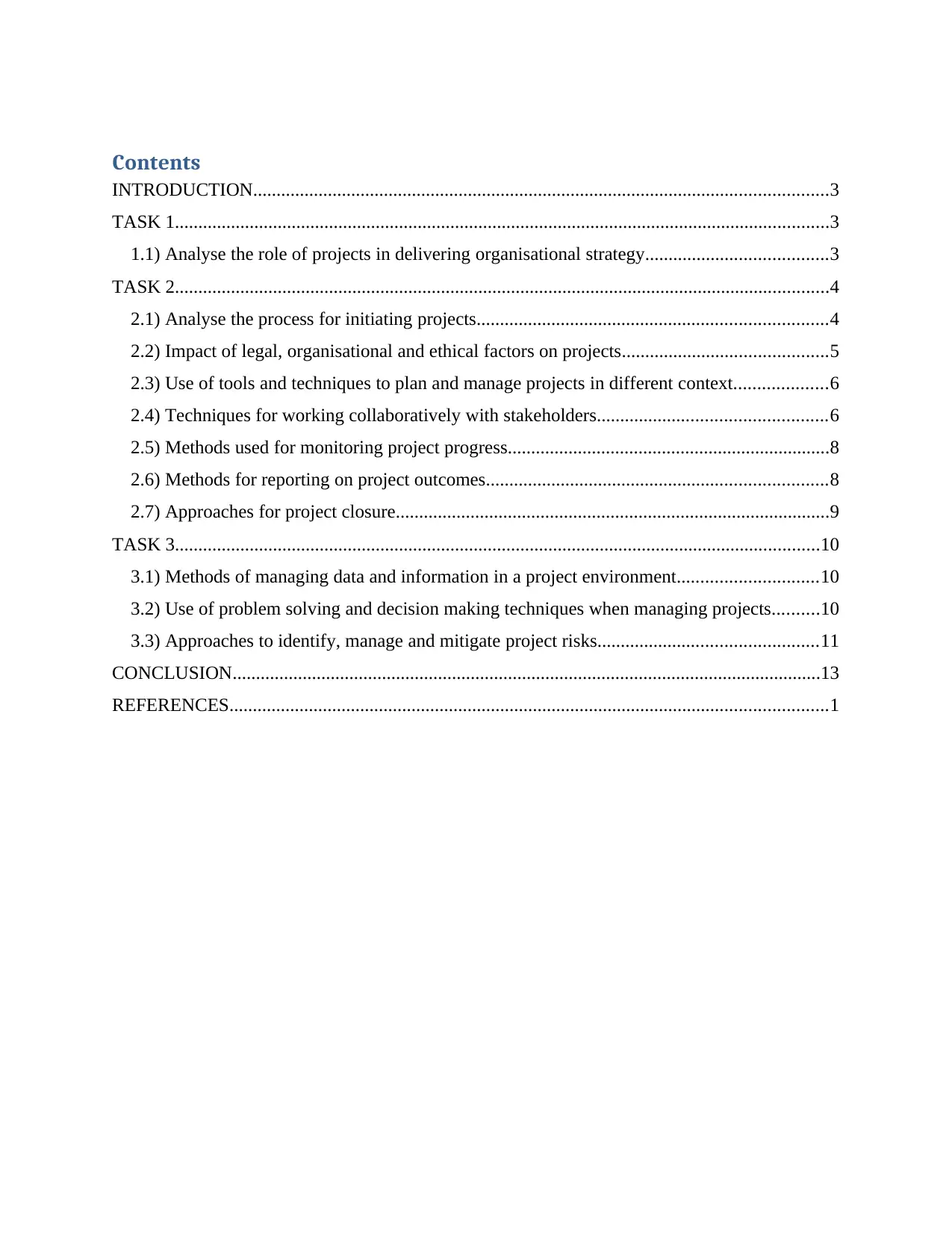
Contents
INTRODUCTION...........................................................................................................................3
TASK 1............................................................................................................................................3
1.1) Analyse the role of projects in delivering organisational strategy.......................................3
TASK 2............................................................................................................................................4
2.1) Analyse the process for initiating projects...........................................................................4
2.2) Impact of legal, organisational and ethical factors on projects............................................5
2.3) Use of tools and techniques to plan and manage projects in different context....................6
2.4) Techniques for working collaboratively with stakeholders.................................................6
2.5) Methods used for monitoring project progress.....................................................................8
2.6) Methods for reporting on project outcomes.........................................................................8
2.7) Approaches for project closure.............................................................................................9
TASK 3..........................................................................................................................................10
3.1) Methods of managing data and information in a project environment..............................10
3.2) Use of problem solving and decision making techniques when managing projects..........10
3.3) Approaches to identify, manage and mitigate project risks...............................................11
CONCLUSION..............................................................................................................................13
REFERENCES................................................................................................................................1
INTRODUCTION...........................................................................................................................3
TASK 1............................................................................................................................................3
1.1) Analyse the role of projects in delivering organisational strategy.......................................3
TASK 2............................................................................................................................................4
2.1) Analyse the process for initiating projects...........................................................................4
2.2) Impact of legal, organisational and ethical factors on projects............................................5
2.3) Use of tools and techniques to plan and manage projects in different context....................6
2.4) Techniques for working collaboratively with stakeholders.................................................6
2.5) Methods used for monitoring project progress.....................................................................8
2.6) Methods for reporting on project outcomes.........................................................................8
2.7) Approaches for project closure.............................................................................................9
TASK 3..........................................................................................................................................10
3.1) Methods of managing data and information in a project environment..............................10
3.2) Use of problem solving and decision making techniques when managing projects..........10
3.3) Approaches to identify, manage and mitigate project risks...............................................11
CONCLUSION..............................................................................................................................13
REFERENCES................................................................................................................................1
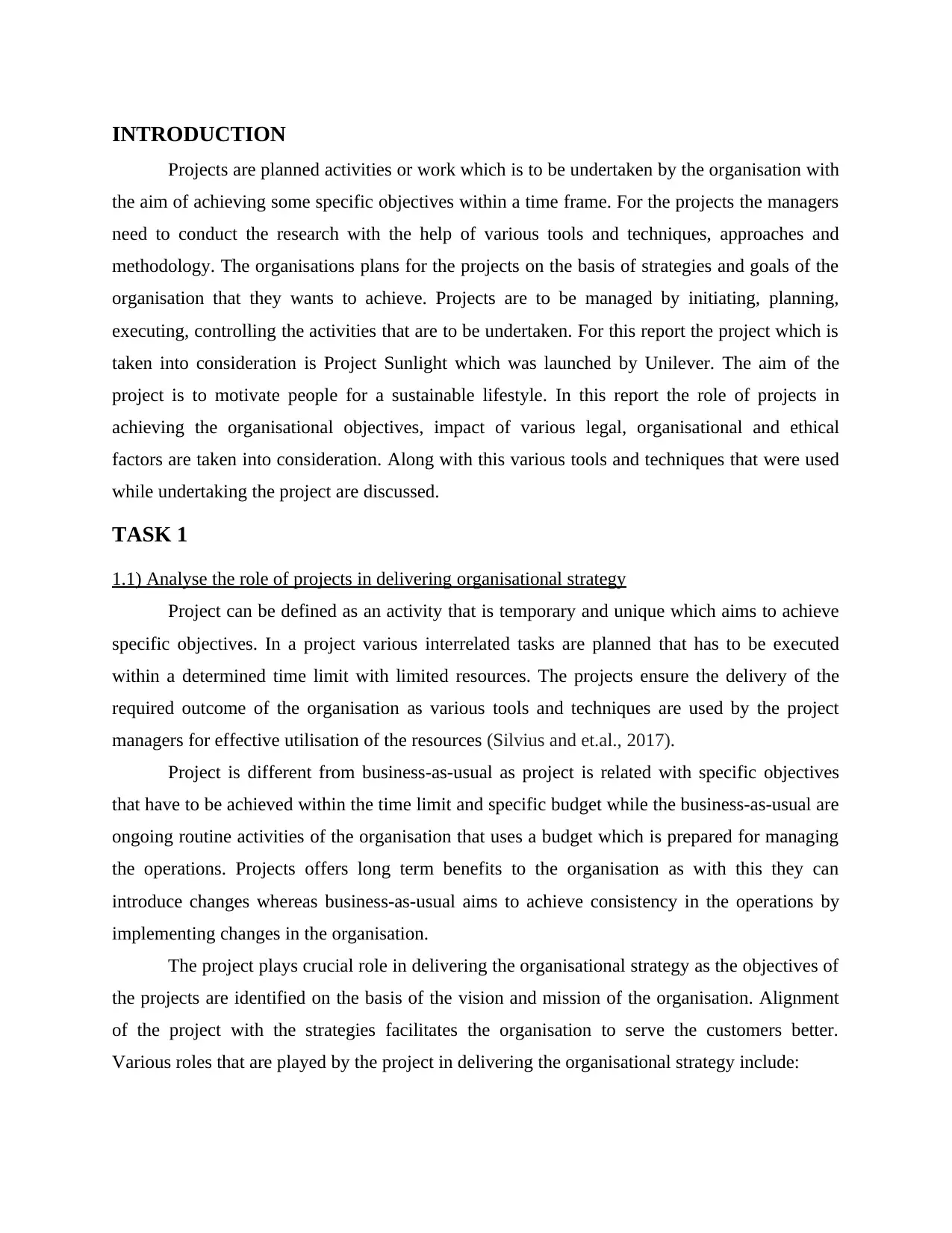
INTRODUCTION
Projects are planned activities or work which is to be undertaken by the organisation with
the aim of achieving some specific objectives within a time frame. For the projects the managers
need to conduct the research with the help of various tools and techniques, approaches and
methodology. The organisations plans for the projects on the basis of strategies and goals of the
organisation that they wants to achieve. Projects are to be managed by initiating, planning,
executing, controlling the activities that are to be undertaken. For this report the project which is
taken into consideration is Project Sunlight which was launched by Unilever. The aim of the
project is to motivate people for a sustainable lifestyle. In this report the role of projects in
achieving the organisational objectives, impact of various legal, organisational and ethical
factors are taken into consideration. Along with this various tools and techniques that were used
while undertaking the project are discussed.
TASK 1
1.1) Analyse the role of projects in delivering organisational strategy
Project can be defined as an activity that is temporary and unique which aims to achieve
specific objectives. In a project various interrelated tasks are planned that has to be executed
within a determined time limit with limited resources. The projects ensure the delivery of the
required outcome of the organisation as various tools and techniques are used by the project
managers for effective utilisation of the resources (Silvius and et.al., 2017).
Project is different from business-as-usual as project is related with specific objectives
that have to be achieved within the time limit and specific budget while the business-as-usual are
ongoing routine activities of the organisation that uses a budget which is prepared for managing
the operations. Projects offers long term benefits to the organisation as with this they can
introduce changes whereas business-as-usual aims to achieve consistency in the operations by
implementing changes in the organisation.
The project plays crucial role in delivering the organisational strategy as the objectives of
the projects are identified on the basis of the vision and mission of the organisation. Alignment
of the project with the strategies facilitates the organisation to serve the customers better.
Various roles that are played by the project in delivering the organisational strategy include:
Projects are planned activities or work which is to be undertaken by the organisation with
the aim of achieving some specific objectives within a time frame. For the projects the managers
need to conduct the research with the help of various tools and techniques, approaches and
methodology. The organisations plans for the projects on the basis of strategies and goals of the
organisation that they wants to achieve. Projects are to be managed by initiating, planning,
executing, controlling the activities that are to be undertaken. For this report the project which is
taken into consideration is Project Sunlight which was launched by Unilever. The aim of the
project is to motivate people for a sustainable lifestyle. In this report the role of projects in
achieving the organisational objectives, impact of various legal, organisational and ethical
factors are taken into consideration. Along with this various tools and techniques that were used
while undertaking the project are discussed.
TASK 1
1.1) Analyse the role of projects in delivering organisational strategy
Project can be defined as an activity that is temporary and unique which aims to achieve
specific objectives. In a project various interrelated tasks are planned that has to be executed
within a determined time limit with limited resources. The projects ensure the delivery of the
required outcome of the organisation as various tools and techniques are used by the project
managers for effective utilisation of the resources (Silvius and et.al., 2017).
Project is different from business-as-usual as project is related with specific objectives
that have to be achieved within the time limit and specific budget while the business-as-usual are
ongoing routine activities of the organisation that uses a budget which is prepared for managing
the operations. Projects offers long term benefits to the organisation as with this they can
introduce changes whereas business-as-usual aims to achieve consistency in the operations by
implementing changes in the organisation.
The project plays crucial role in delivering the organisational strategy as the objectives of
the projects are identified on the basis of the vision and mission of the organisation. Alignment
of the project with the strategies facilitates the organisation to serve the customers better.
Various roles that are played by the project in delivering the organisational strategy include:
⊘ This is a preview!⊘
Do you want full access?
Subscribe today to unlock all pages.

Trusted by 1+ million students worldwide
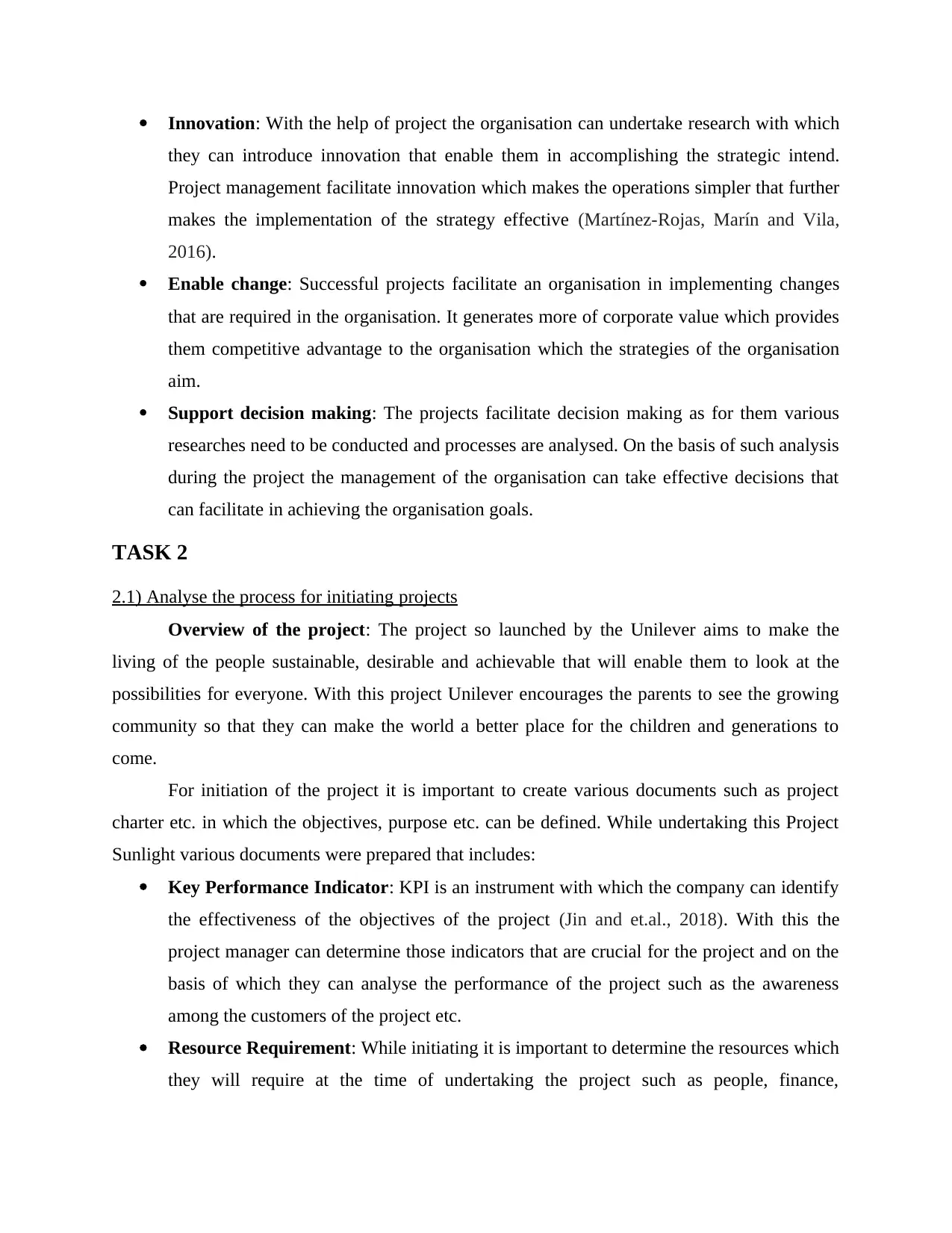
Innovation: With the help of project the organisation can undertake research with which
they can introduce innovation that enable them in accomplishing the strategic intend.
Project management facilitate innovation which makes the operations simpler that further
makes the implementation of the strategy effective (Martínez-Rojas, Marín and Vila,
2016).
Enable change: Successful projects facilitate an organisation in implementing changes
that are required in the organisation. It generates more of corporate value which provides
them competitive advantage to the organisation which the strategies of the organisation
aim.
Support decision making: The projects facilitate decision making as for them various
researches need to be conducted and processes are analysed. On the basis of such analysis
during the project the management of the organisation can take effective decisions that
can facilitate in achieving the organisation goals.
TASK 2
2.1) Analyse the process for initiating projects
Overview of the project: The project so launched by the Unilever aims to make the
living of the people sustainable, desirable and achievable that will enable them to look at the
possibilities for everyone. With this project Unilever encourages the parents to see the growing
community so that they can make the world a better place for the children and generations to
come.
For initiation of the project it is important to create various documents such as project
charter etc. in which the objectives, purpose etc. can be defined. While undertaking this Project
Sunlight various documents were prepared that includes:
Key Performance Indicator: KPI is an instrument with which the company can identify
the effectiveness of the objectives of the project (Jin and et.al., 2018). With this the
project manager can determine those indicators that are crucial for the project and on the
basis of which they can analyse the performance of the project such as the awareness
among the customers of the project etc.
Resource Requirement: While initiating it is important to determine the resources which
they will require at the time of undertaking the project such as people, finance,
they can introduce innovation that enable them in accomplishing the strategic intend.
Project management facilitate innovation which makes the operations simpler that further
makes the implementation of the strategy effective (Martínez-Rojas, Marín and Vila,
2016).
Enable change: Successful projects facilitate an organisation in implementing changes
that are required in the organisation. It generates more of corporate value which provides
them competitive advantage to the organisation which the strategies of the organisation
aim.
Support decision making: The projects facilitate decision making as for them various
researches need to be conducted and processes are analysed. On the basis of such analysis
during the project the management of the organisation can take effective decisions that
can facilitate in achieving the organisation goals.
TASK 2
2.1) Analyse the process for initiating projects
Overview of the project: The project so launched by the Unilever aims to make the
living of the people sustainable, desirable and achievable that will enable them to look at the
possibilities for everyone. With this project Unilever encourages the parents to see the growing
community so that they can make the world a better place for the children and generations to
come.
For initiation of the project it is important to create various documents such as project
charter etc. in which the objectives, purpose etc. can be defined. While undertaking this Project
Sunlight various documents were prepared that includes:
Key Performance Indicator: KPI is an instrument with which the company can identify
the effectiveness of the objectives of the project (Jin and et.al., 2018). With this the
project manager can determine those indicators that are crucial for the project and on the
basis of which they can analyse the performance of the project such as the awareness
among the customers of the project etc.
Resource Requirement: While initiating it is important to determine the resources which
they will require at the time of undertaking the project such as people, finance,
Paraphrase This Document
Need a fresh take? Get an instant paraphrase of this document with our AI Paraphraser
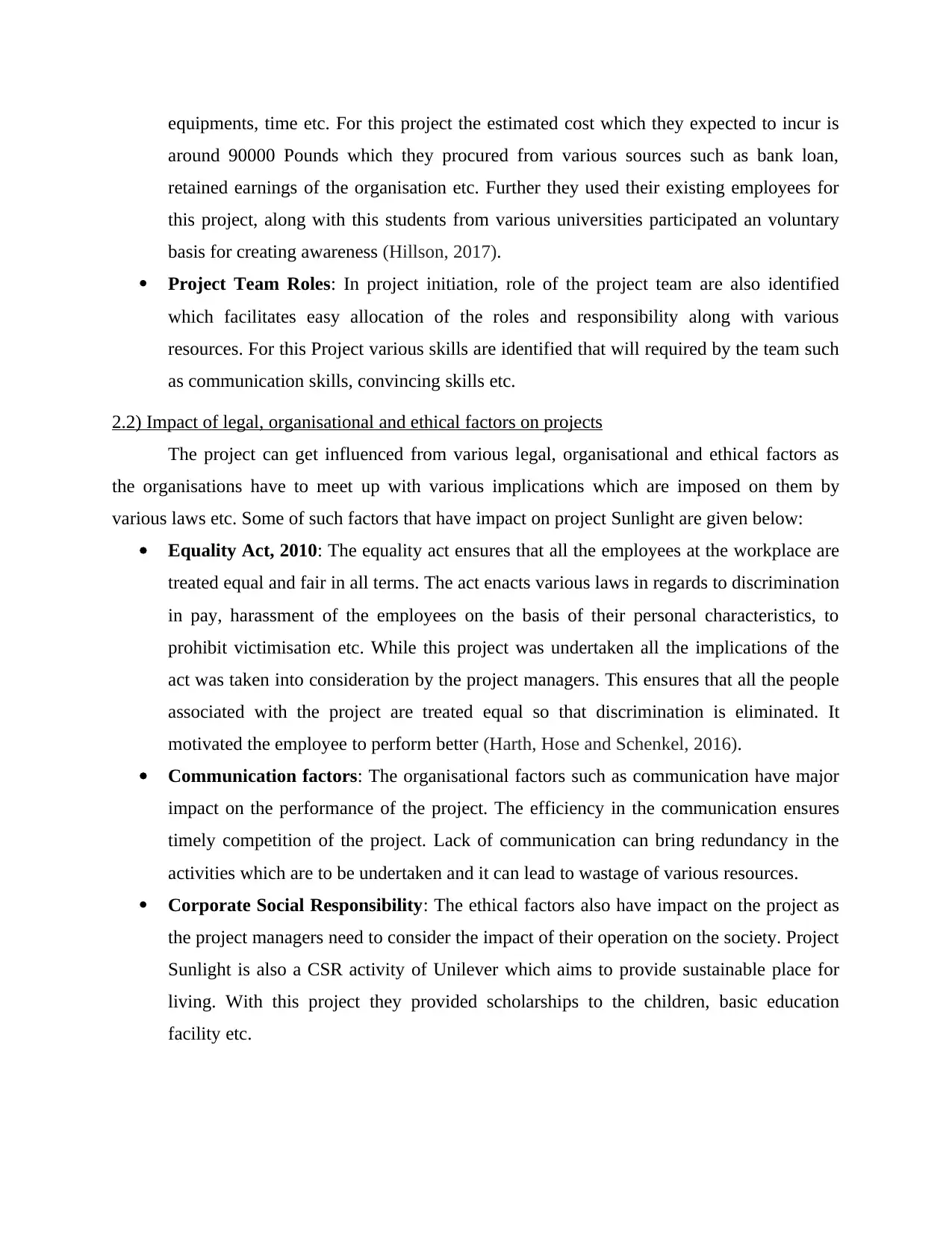
equipments, time etc. For this project the estimated cost which they expected to incur is
around 90000 Pounds which they procured from various sources such as bank loan,
retained earnings of the organisation etc. Further they used their existing employees for
this project, along with this students from various universities participated an voluntary
basis for creating awareness (Hillson, 2017).
Project Team Roles: In project initiation, role of the project team are also identified
which facilitates easy allocation of the roles and responsibility along with various
resources. For this Project various skills are identified that will required by the team such
as communication skills, convincing skills etc.
2.2) Impact of legal, organisational and ethical factors on projects
The project can get influenced from various legal, organisational and ethical factors as
the organisations have to meet up with various implications which are imposed on them by
various laws etc. Some of such factors that have impact on project Sunlight are given below:
Equality Act, 2010: The equality act ensures that all the employees at the workplace are
treated equal and fair in all terms. The act enacts various laws in regards to discrimination
in pay, harassment of the employees on the basis of their personal characteristics, to
prohibit victimisation etc. While this project was undertaken all the implications of the
act was taken into consideration by the project managers. This ensures that all the people
associated with the project are treated equal so that discrimination is eliminated. It
motivated the employee to perform better (Harth, Hose and Schenkel, 2016).
Communication factors: The organisational factors such as communication have major
impact on the performance of the project. The efficiency in the communication ensures
timely competition of the project. Lack of communication can bring redundancy in the
activities which are to be undertaken and it can lead to wastage of various resources.
Corporate Social Responsibility: The ethical factors also have impact on the project as
the project managers need to consider the impact of their operation on the society. Project
Sunlight is also a CSR activity of Unilever which aims to provide sustainable place for
living. With this project they provided scholarships to the children, basic education
facility etc.
around 90000 Pounds which they procured from various sources such as bank loan,
retained earnings of the organisation etc. Further they used their existing employees for
this project, along with this students from various universities participated an voluntary
basis for creating awareness (Hillson, 2017).
Project Team Roles: In project initiation, role of the project team are also identified
which facilitates easy allocation of the roles and responsibility along with various
resources. For this Project various skills are identified that will required by the team such
as communication skills, convincing skills etc.
2.2) Impact of legal, organisational and ethical factors on projects
The project can get influenced from various legal, organisational and ethical factors as
the organisations have to meet up with various implications which are imposed on them by
various laws etc. Some of such factors that have impact on project Sunlight are given below:
Equality Act, 2010: The equality act ensures that all the employees at the workplace are
treated equal and fair in all terms. The act enacts various laws in regards to discrimination
in pay, harassment of the employees on the basis of their personal characteristics, to
prohibit victimisation etc. While this project was undertaken all the implications of the
act was taken into consideration by the project managers. This ensures that all the people
associated with the project are treated equal so that discrimination is eliminated. It
motivated the employee to perform better (Harth, Hose and Schenkel, 2016).
Communication factors: The organisational factors such as communication have major
impact on the performance of the project. The efficiency in the communication ensures
timely competition of the project. Lack of communication can bring redundancy in the
activities which are to be undertaken and it can lead to wastage of various resources.
Corporate Social Responsibility: The ethical factors also have impact on the project as
the project managers need to consider the impact of their operation on the society. Project
Sunlight is also a CSR activity of Unilever which aims to provide sustainable place for
living. With this project they provided scholarships to the children, basic education
facility etc.
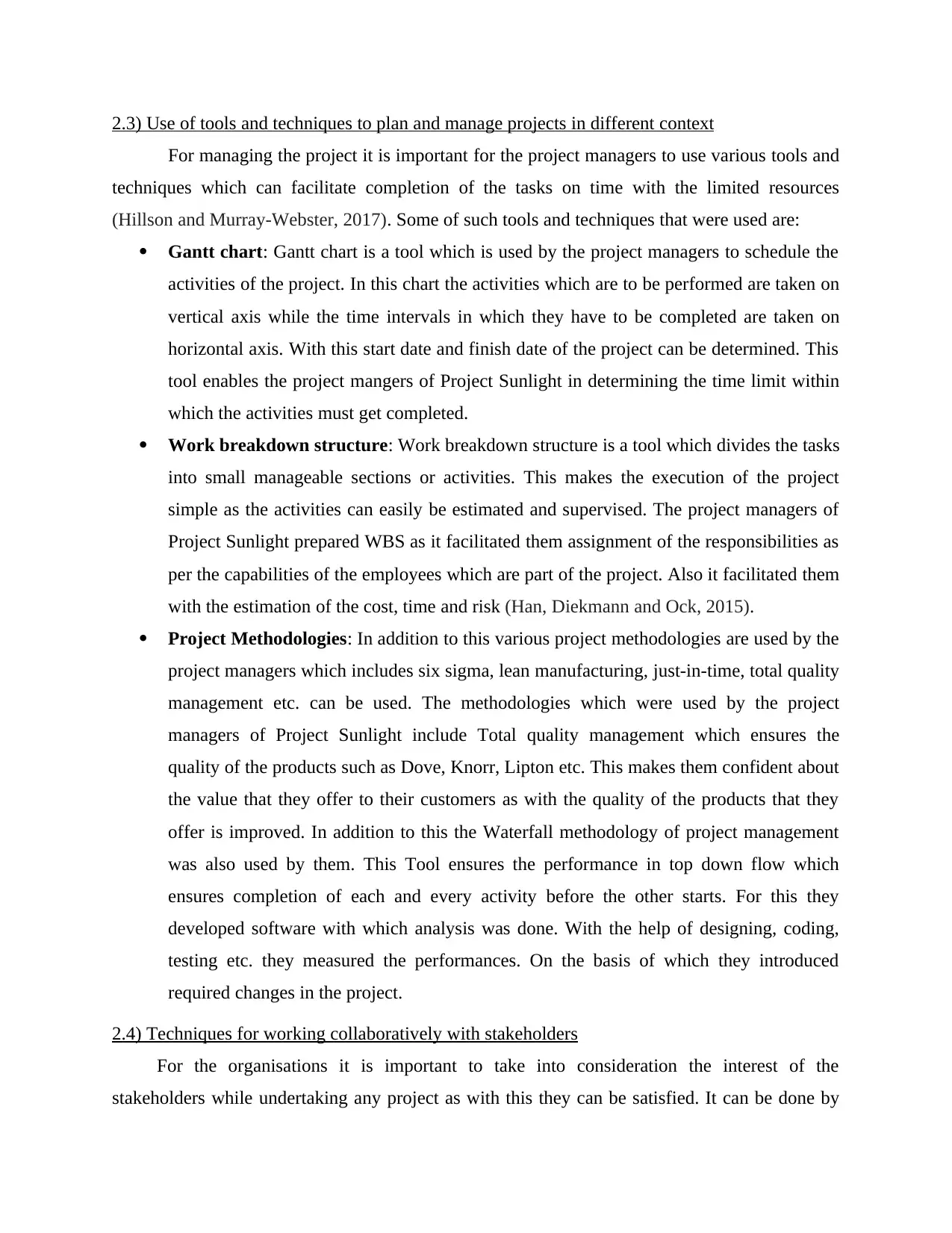
2.3) Use of tools and techniques to plan and manage projects in different context
For managing the project it is important for the project managers to use various tools and
techniques which can facilitate completion of the tasks on time with the limited resources
(Hillson and Murray-Webster, 2017). Some of such tools and techniques that were used are:
Gantt chart: Gantt chart is a tool which is used by the project managers to schedule the
activities of the project. In this chart the activities which are to be performed are taken on
vertical axis while the time intervals in which they have to be completed are taken on
horizontal axis. With this start date and finish date of the project can be determined. This
tool enables the project mangers of Project Sunlight in determining the time limit within
which the activities must get completed.
Work breakdown structure: Work breakdown structure is a tool which divides the tasks
into small manageable sections or activities. This makes the execution of the project
simple as the activities can easily be estimated and supervised. The project managers of
Project Sunlight prepared WBS as it facilitated them assignment of the responsibilities as
per the capabilities of the employees which are part of the project. Also it facilitated them
with the estimation of the cost, time and risk (Han, Diekmann and Ock, 2015).
Project Methodologies: In addition to this various project methodologies are used by the
project managers which includes six sigma, lean manufacturing, just-in-time, total quality
management etc. can be used. The methodologies which were used by the project
managers of Project Sunlight include Total quality management which ensures the
quality of the products such as Dove, Knorr, Lipton etc. This makes them confident about
the value that they offer to their customers as with the quality of the products that they
offer is improved. In addition to this the Waterfall methodology of project management
was also used by them. This Tool ensures the performance in top down flow which
ensures completion of each and every activity before the other starts. For this they
developed software with which analysis was done. With the help of designing, coding,
testing etc. they measured the performances. On the basis of which they introduced
required changes in the project.
2.4) Techniques for working collaboratively with stakeholders
For the organisations it is important to take into consideration the interest of the
stakeholders while undertaking any project as with this they can be satisfied. It can be done by
For managing the project it is important for the project managers to use various tools and
techniques which can facilitate completion of the tasks on time with the limited resources
(Hillson and Murray-Webster, 2017). Some of such tools and techniques that were used are:
Gantt chart: Gantt chart is a tool which is used by the project managers to schedule the
activities of the project. In this chart the activities which are to be performed are taken on
vertical axis while the time intervals in which they have to be completed are taken on
horizontal axis. With this start date and finish date of the project can be determined. This
tool enables the project mangers of Project Sunlight in determining the time limit within
which the activities must get completed.
Work breakdown structure: Work breakdown structure is a tool which divides the tasks
into small manageable sections or activities. This makes the execution of the project
simple as the activities can easily be estimated and supervised. The project managers of
Project Sunlight prepared WBS as it facilitated them assignment of the responsibilities as
per the capabilities of the employees which are part of the project. Also it facilitated them
with the estimation of the cost, time and risk (Han, Diekmann and Ock, 2015).
Project Methodologies: In addition to this various project methodologies are used by the
project managers which includes six sigma, lean manufacturing, just-in-time, total quality
management etc. can be used. The methodologies which were used by the project
managers of Project Sunlight include Total quality management which ensures the
quality of the products such as Dove, Knorr, Lipton etc. This makes them confident about
the value that they offer to their customers as with the quality of the products that they
offer is improved. In addition to this the Waterfall methodology of project management
was also used by them. This Tool ensures the performance in top down flow which
ensures completion of each and every activity before the other starts. For this they
developed software with which analysis was done. With the help of designing, coding,
testing etc. they measured the performances. On the basis of which they introduced
required changes in the project.
2.4) Techniques for working collaboratively with stakeholders
For the organisations it is important to take into consideration the interest of the
stakeholders while undertaking any project as with this they can be satisfied. It can be done by
⊘ This is a preview!⊘
Do you want full access?
Subscribe today to unlock all pages.

Trusted by 1+ million students worldwide
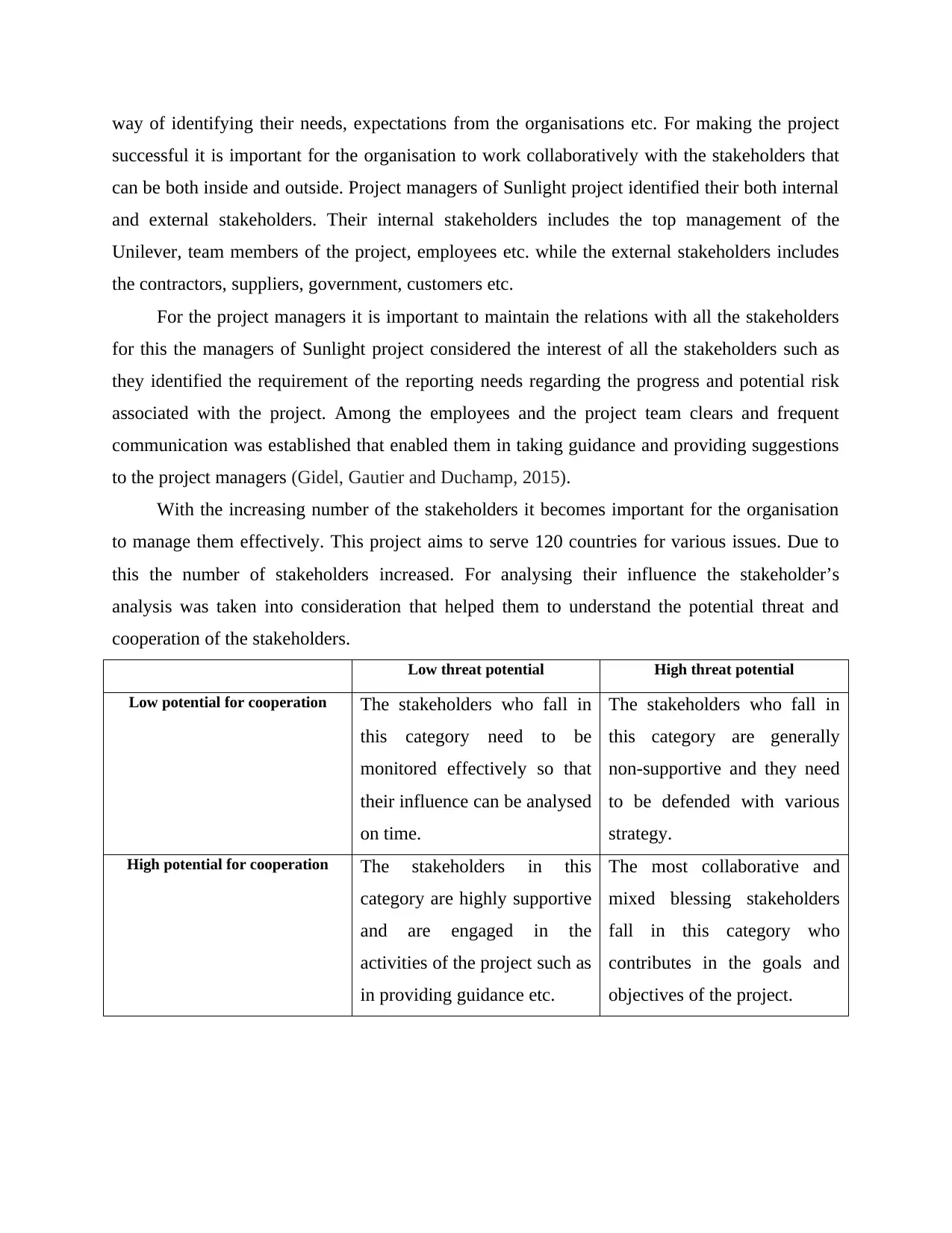
way of identifying their needs, expectations from the organisations etc. For making the project
successful it is important for the organisation to work collaboratively with the stakeholders that
can be both inside and outside. Project managers of Sunlight project identified their both internal
and external stakeholders. Their internal stakeholders includes the top management of the
Unilever, team members of the project, employees etc. while the external stakeholders includes
the contractors, suppliers, government, customers etc.
For the project managers it is important to maintain the relations with all the stakeholders
for this the managers of Sunlight project considered the interest of all the stakeholders such as
they identified the requirement of the reporting needs regarding the progress and potential risk
associated with the project. Among the employees and the project team clears and frequent
communication was established that enabled them in taking guidance and providing suggestions
to the project managers (Gidel, Gautier and Duchamp, 2015).
With the increasing number of the stakeholders it becomes important for the organisation
to manage them effectively. This project aims to serve 120 countries for various issues. Due to
this the number of stakeholders increased. For analysing their influence the stakeholder’s
analysis was taken into consideration that helped them to understand the potential threat and
cooperation of the stakeholders.
Low threat potential High threat potential
Low potential for cooperation The stakeholders who fall in
this category need to be
monitored effectively so that
their influence can be analysed
on time.
The stakeholders who fall in
this category are generally
non-supportive and they need
to be defended with various
strategy.
High potential for cooperation The stakeholders in this
category are highly supportive
and are engaged in the
activities of the project such as
in providing guidance etc.
The most collaborative and
mixed blessing stakeholders
fall in this category who
contributes in the goals and
objectives of the project.
successful it is important for the organisation to work collaboratively with the stakeholders that
can be both inside and outside. Project managers of Sunlight project identified their both internal
and external stakeholders. Their internal stakeholders includes the top management of the
Unilever, team members of the project, employees etc. while the external stakeholders includes
the contractors, suppliers, government, customers etc.
For the project managers it is important to maintain the relations with all the stakeholders
for this the managers of Sunlight project considered the interest of all the stakeholders such as
they identified the requirement of the reporting needs regarding the progress and potential risk
associated with the project. Among the employees and the project team clears and frequent
communication was established that enabled them in taking guidance and providing suggestions
to the project managers (Gidel, Gautier and Duchamp, 2015).
With the increasing number of the stakeholders it becomes important for the organisation
to manage them effectively. This project aims to serve 120 countries for various issues. Due to
this the number of stakeholders increased. For analysing their influence the stakeholder’s
analysis was taken into consideration that helped them to understand the potential threat and
cooperation of the stakeholders.
Low threat potential High threat potential
Low potential for cooperation The stakeholders who fall in
this category need to be
monitored effectively so that
their influence can be analysed
on time.
The stakeholders who fall in
this category are generally
non-supportive and they need
to be defended with various
strategy.
High potential for cooperation The stakeholders in this
category are highly supportive
and are engaged in the
activities of the project such as
in providing guidance etc.
The most collaborative and
mixed blessing stakeholders
fall in this category who
contributes in the goals and
objectives of the project.
Paraphrase This Document
Need a fresh take? Get an instant paraphrase of this document with our AI Paraphraser
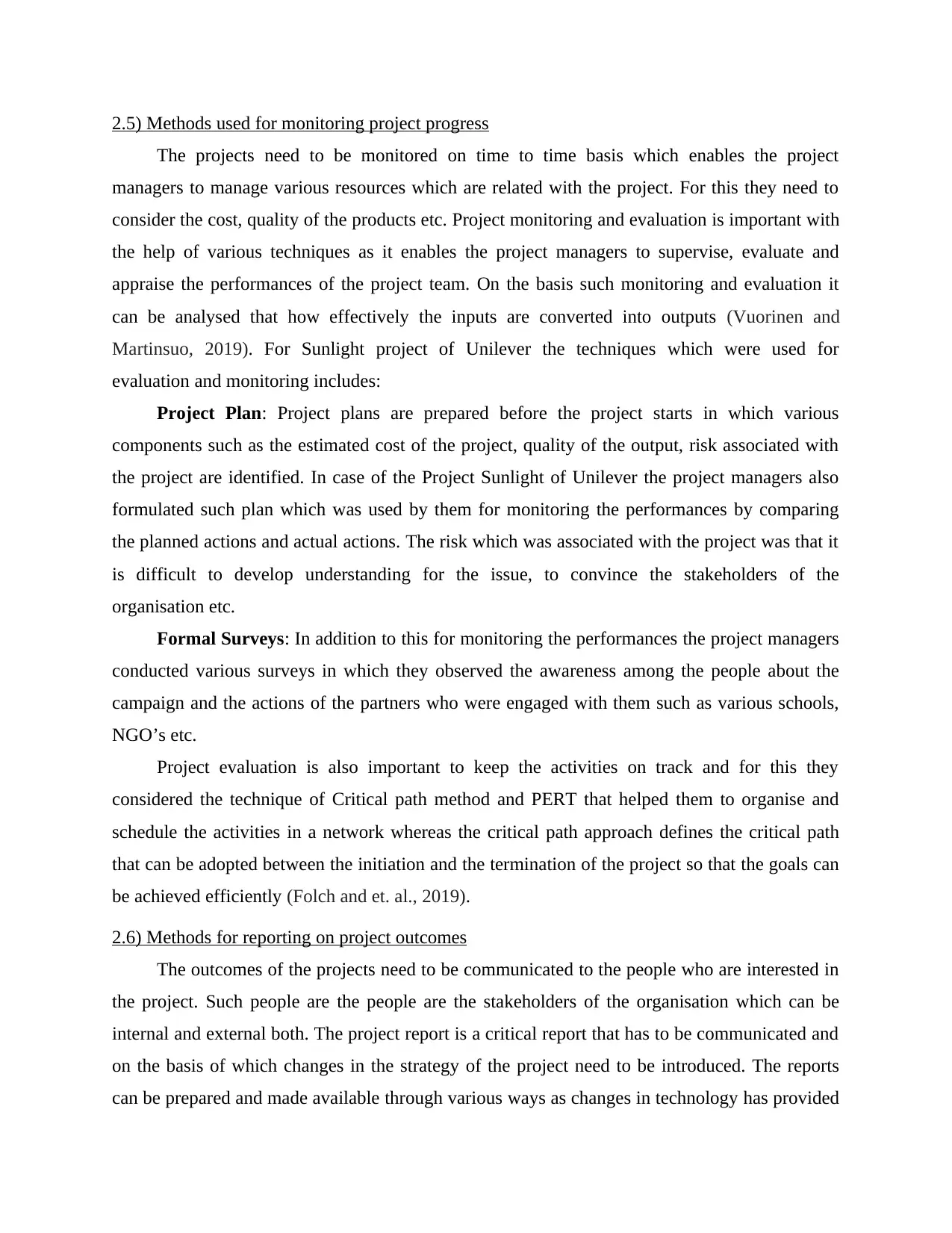
2.5) Methods used for monitoring project progress
The projects need to be monitored on time to time basis which enables the project
managers to manage various resources which are related with the project. For this they need to
consider the cost, quality of the products etc. Project monitoring and evaluation is important with
the help of various techniques as it enables the project managers to supervise, evaluate and
appraise the performances of the project team. On the basis such monitoring and evaluation it
can be analysed that how effectively the inputs are converted into outputs (Vuorinen and
Martinsuo, 2019). For Sunlight project of Unilever the techniques which were used for
evaluation and monitoring includes:
Project Plan: Project plans are prepared before the project starts in which various
components such as the estimated cost of the project, quality of the output, risk associated with
the project are identified. In case of the Project Sunlight of Unilever the project managers also
formulated such plan which was used by them for monitoring the performances by comparing
the planned actions and actual actions. The risk which was associated with the project was that it
is difficult to develop understanding for the issue, to convince the stakeholders of the
organisation etc.
Formal Surveys: In addition to this for monitoring the performances the project managers
conducted various surveys in which they observed the awareness among the people about the
campaign and the actions of the partners who were engaged with them such as various schools,
NGO’s etc.
Project evaluation is also important to keep the activities on track and for this they
considered the technique of Critical path method and PERT that helped them to organise and
schedule the activities in a network whereas the critical path approach defines the critical path
that can be adopted between the initiation and the termination of the project so that the goals can
be achieved efficiently (Folch and et. al., 2019).
2.6) Methods for reporting on project outcomes
The outcomes of the projects need to be communicated to the people who are interested in
the project. Such people are the people are the stakeholders of the organisation which can be
internal and external both. The project report is a critical report that has to be communicated and
on the basis of which changes in the strategy of the project need to be introduced. The reports
can be prepared and made available through various ways as changes in technology has provided
The projects need to be monitored on time to time basis which enables the project
managers to manage various resources which are related with the project. For this they need to
consider the cost, quality of the products etc. Project monitoring and evaluation is important with
the help of various techniques as it enables the project managers to supervise, evaluate and
appraise the performances of the project team. On the basis such monitoring and evaluation it
can be analysed that how effectively the inputs are converted into outputs (Vuorinen and
Martinsuo, 2019). For Sunlight project of Unilever the techniques which were used for
evaluation and monitoring includes:
Project Plan: Project plans are prepared before the project starts in which various
components such as the estimated cost of the project, quality of the output, risk associated with
the project are identified. In case of the Project Sunlight of Unilever the project managers also
formulated such plan which was used by them for monitoring the performances by comparing
the planned actions and actual actions. The risk which was associated with the project was that it
is difficult to develop understanding for the issue, to convince the stakeholders of the
organisation etc.
Formal Surveys: In addition to this for monitoring the performances the project managers
conducted various surveys in which they observed the awareness among the people about the
campaign and the actions of the partners who were engaged with them such as various schools,
NGO’s etc.
Project evaluation is also important to keep the activities on track and for this they
considered the technique of Critical path method and PERT that helped them to organise and
schedule the activities in a network whereas the critical path approach defines the critical path
that can be adopted between the initiation and the termination of the project so that the goals can
be achieved efficiently (Folch and et. al., 2019).
2.6) Methods for reporting on project outcomes
The outcomes of the projects need to be communicated to the people who are interested in
the project. Such people are the people are the stakeholders of the organisation which can be
internal and external both. The project report is a critical report that has to be communicated and
on the basis of which changes in the strategy of the project need to be introduced. The reports
can be prepared and made available through various ways as changes in technology has provided
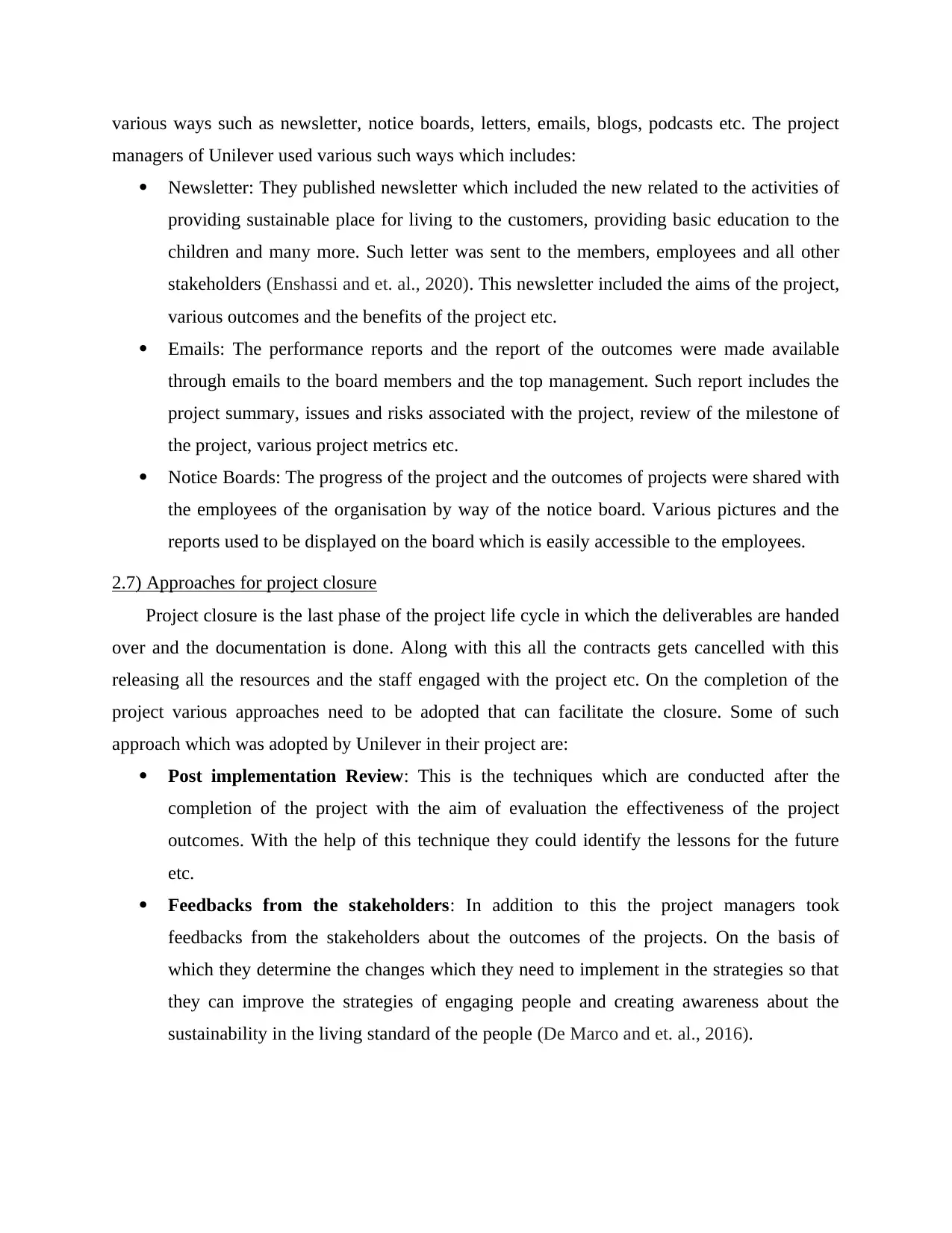
various ways such as newsletter, notice boards, letters, emails, blogs, podcasts etc. The project
managers of Unilever used various such ways which includes:
Newsletter: They published newsletter which included the new related to the activities of
providing sustainable place for living to the customers, providing basic education to the
children and many more. Such letter was sent to the members, employees and all other
stakeholders (Enshassi and et. al., 2020). This newsletter included the aims of the project,
various outcomes and the benefits of the project etc.
Emails: The performance reports and the report of the outcomes were made available
through emails to the board members and the top management. Such report includes the
project summary, issues and risks associated with the project, review of the milestone of
the project, various project metrics etc.
Notice Boards: The progress of the project and the outcomes of projects were shared with
the employees of the organisation by way of the notice board. Various pictures and the
reports used to be displayed on the board which is easily accessible to the employees.
2.7) Approaches for project closure
Project closure is the last phase of the project life cycle in which the deliverables are handed
over and the documentation is done. Along with this all the contracts gets cancelled with this
releasing all the resources and the staff engaged with the project etc. On the completion of the
project various approaches need to be adopted that can facilitate the closure. Some of such
approach which was adopted by Unilever in their project are:
Post implementation Review: This is the techniques which are conducted after the
completion of the project with the aim of evaluation the effectiveness of the project
outcomes. With the help of this technique they could identify the lessons for the future
etc.
Feedbacks from the stakeholders: In addition to this the project managers took
feedbacks from the stakeholders about the outcomes of the projects. On the basis of
which they determine the changes which they need to implement in the strategies so that
they can improve the strategies of engaging people and creating awareness about the
sustainability in the living standard of the people (De Marco and et. al., 2016).
managers of Unilever used various such ways which includes:
Newsletter: They published newsletter which included the new related to the activities of
providing sustainable place for living to the customers, providing basic education to the
children and many more. Such letter was sent to the members, employees and all other
stakeholders (Enshassi and et. al., 2020). This newsletter included the aims of the project,
various outcomes and the benefits of the project etc.
Emails: The performance reports and the report of the outcomes were made available
through emails to the board members and the top management. Such report includes the
project summary, issues and risks associated with the project, review of the milestone of
the project, various project metrics etc.
Notice Boards: The progress of the project and the outcomes of projects were shared with
the employees of the organisation by way of the notice board. Various pictures and the
reports used to be displayed on the board which is easily accessible to the employees.
2.7) Approaches for project closure
Project closure is the last phase of the project life cycle in which the deliverables are handed
over and the documentation is done. Along with this all the contracts gets cancelled with this
releasing all the resources and the staff engaged with the project etc. On the completion of the
project various approaches need to be adopted that can facilitate the closure. Some of such
approach which was adopted by Unilever in their project are:
Post implementation Review: This is the techniques which are conducted after the
completion of the project with the aim of evaluation the effectiveness of the project
outcomes. With the help of this technique they could identify the lessons for the future
etc.
Feedbacks from the stakeholders: In addition to this the project managers took
feedbacks from the stakeholders about the outcomes of the projects. On the basis of
which they determine the changes which they need to implement in the strategies so that
they can improve the strategies of engaging people and creating awareness about the
sustainability in the living standard of the people (De Marco and et. al., 2016).
⊘ This is a preview!⊘
Do you want full access?
Subscribe today to unlock all pages.

Trusted by 1+ million students worldwide
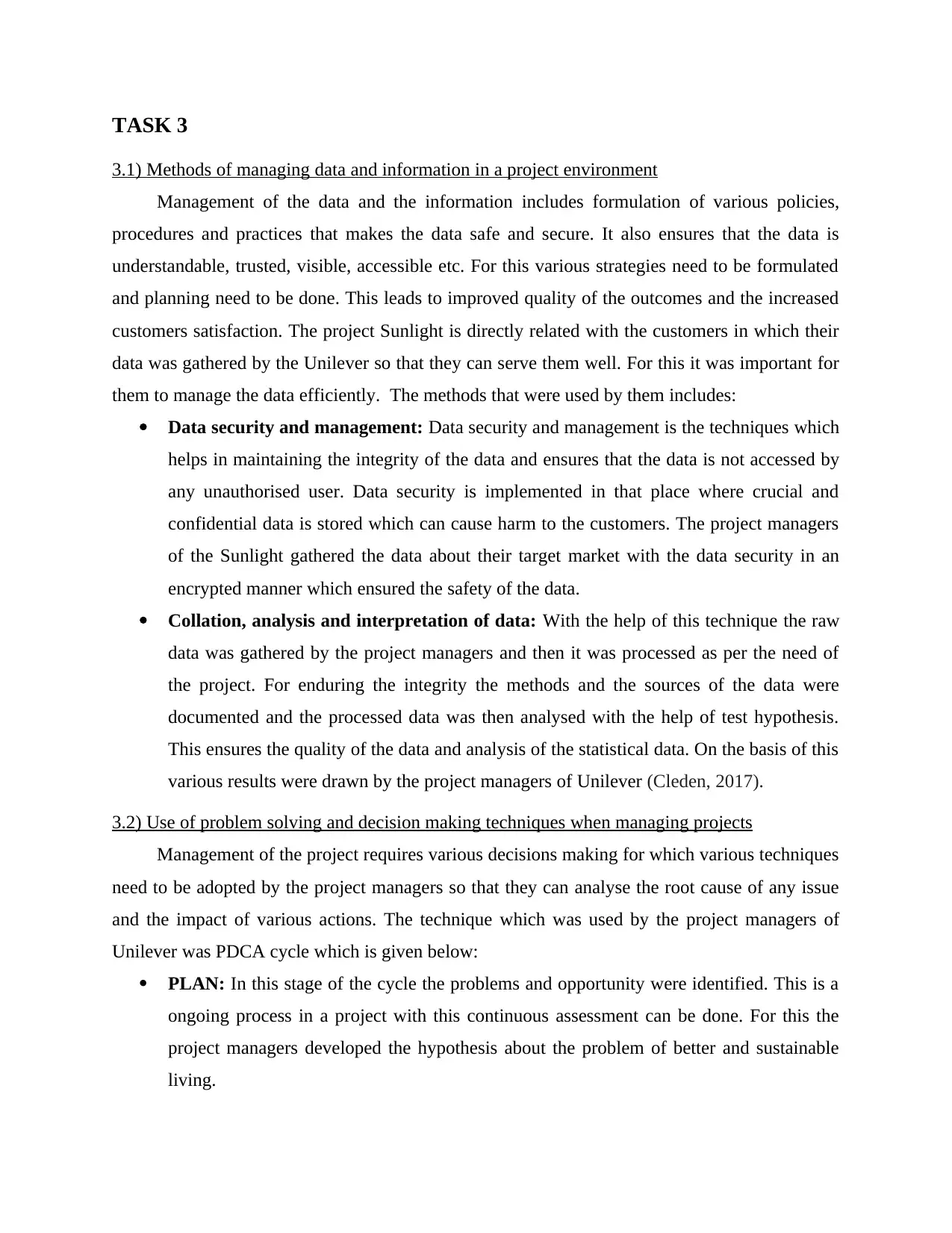
TASK 3
3.1) Methods of managing data and information in a project environment
Management of the data and the information includes formulation of various policies,
procedures and practices that makes the data safe and secure. It also ensures that the data is
understandable, trusted, visible, accessible etc. For this various strategies need to be formulated
and planning need to be done. This leads to improved quality of the outcomes and the increased
customers satisfaction. The project Sunlight is directly related with the customers in which their
data was gathered by the Unilever so that they can serve them well. For this it was important for
them to manage the data efficiently. The methods that were used by them includes:
Data security and management: Data security and management is the techniques which
helps in maintaining the integrity of the data and ensures that the data is not accessed by
any unauthorised user. Data security is implemented in that place where crucial and
confidential data is stored which can cause harm to the customers. The project managers
of the Sunlight gathered the data about their target market with the data security in an
encrypted manner which ensured the safety of the data.
Collation, analysis and interpretation of data: With the help of this technique the raw
data was gathered by the project managers and then it was processed as per the need of
the project. For enduring the integrity the methods and the sources of the data were
documented and the processed data was then analysed with the help of test hypothesis.
This ensures the quality of the data and analysis of the statistical data. On the basis of this
various results were drawn by the project managers of Unilever (Cleden, 2017).
3.2) Use of problem solving and decision making techniques when managing projects
Management of the project requires various decisions making for which various techniques
need to be adopted by the project managers so that they can analyse the root cause of any issue
and the impact of various actions. The technique which was used by the project managers of
Unilever was PDCA cycle which is given below:
PLAN: In this stage of the cycle the problems and opportunity were identified. This is a
ongoing process in a project with this continuous assessment can be done. For this the
project managers developed the hypothesis about the problem of better and sustainable
living.
3.1) Methods of managing data and information in a project environment
Management of the data and the information includes formulation of various policies,
procedures and practices that makes the data safe and secure. It also ensures that the data is
understandable, trusted, visible, accessible etc. For this various strategies need to be formulated
and planning need to be done. This leads to improved quality of the outcomes and the increased
customers satisfaction. The project Sunlight is directly related with the customers in which their
data was gathered by the Unilever so that they can serve them well. For this it was important for
them to manage the data efficiently. The methods that were used by them includes:
Data security and management: Data security and management is the techniques which
helps in maintaining the integrity of the data and ensures that the data is not accessed by
any unauthorised user. Data security is implemented in that place where crucial and
confidential data is stored which can cause harm to the customers. The project managers
of the Sunlight gathered the data about their target market with the data security in an
encrypted manner which ensured the safety of the data.
Collation, analysis and interpretation of data: With the help of this technique the raw
data was gathered by the project managers and then it was processed as per the need of
the project. For enduring the integrity the methods and the sources of the data were
documented and the processed data was then analysed with the help of test hypothesis.
This ensures the quality of the data and analysis of the statistical data. On the basis of this
various results were drawn by the project managers of Unilever (Cleden, 2017).
3.2) Use of problem solving and decision making techniques when managing projects
Management of the project requires various decisions making for which various techniques
need to be adopted by the project managers so that they can analyse the root cause of any issue
and the impact of various actions. The technique which was used by the project managers of
Unilever was PDCA cycle which is given below:
PLAN: In this stage of the cycle the problems and opportunity were identified. This is a
ongoing process in a project with this continuous assessment can be done. For this the
project managers developed the hypothesis about the problem of better and sustainable
living.
Paraphrase This Document
Need a fresh take? Get an instant paraphrase of this document with our AI Paraphraser
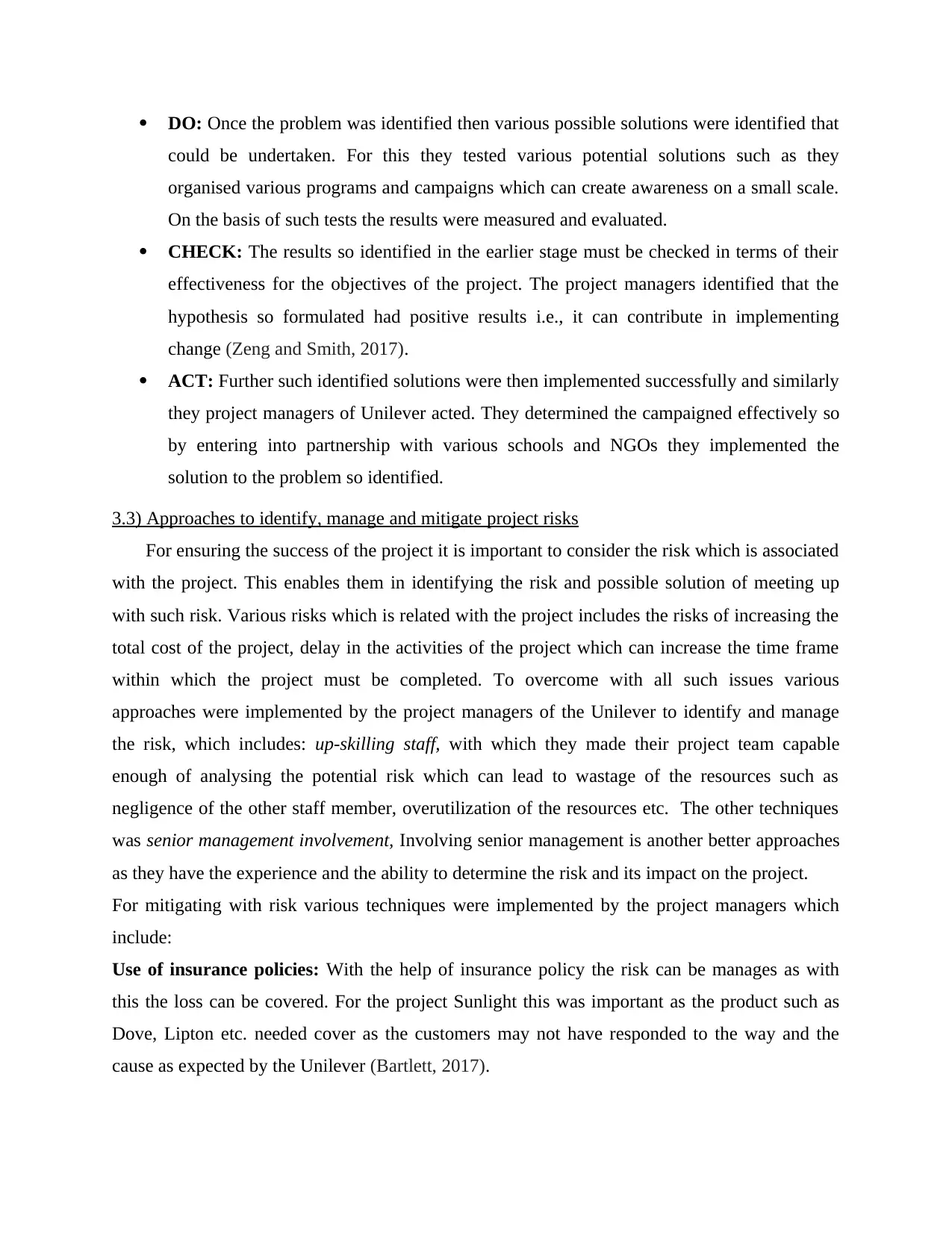
DO: Once the problem was identified then various possible solutions were identified that
could be undertaken. For this they tested various potential solutions such as they
organised various programs and campaigns which can create awareness on a small scale.
On the basis of such tests the results were measured and evaluated.
CHECK: The results so identified in the earlier stage must be checked in terms of their
effectiveness for the objectives of the project. The project managers identified that the
hypothesis so formulated had positive results i.e., it can contribute in implementing
change (Zeng and Smith, 2017).
ACT: Further such identified solutions were then implemented successfully and similarly
they project managers of Unilever acted. They determined the campaigned effectively so
by entering into partnership with various schools and NGOs they implemented the
solution to the problem so identified.
3.3) Approaches to identify, manage and mitigate project risks
For ensuring the success of the project it is important to consider the risk which is associated
with the project. This enables them in identifying the risk and possible solution of meeting up
with such risk. Various risks which is related with the project includes the risks of increasing the
total cost of the project, delay in the activities of the project which can increase the time frame
within which the project must be completed. To overcome with all such issues various
approaches were implemented by the project managers of the Unilever to identify and manage
the risk, which includes: up-skilling staff, with which they made their project team capable
enough of analysing the potential risk which can lead to wastage of the resources such as
negligence of the other staff member, overutilization of the resources etc. The other techniques
was senior management involvement, Involving senior management is another better approaches
as they have the experience and the ability to determine the risk and its impact on the project.
For mitigating with risk various techniques were implemented by the project managers which
include:
Use of insurance policies: With the help of insurance policy the risk can be manages as with
this the loss can be covered. For the project Sunlight this was important as the product such as
Dove, Lipton etc. needed cover as the customers may not have responded to the way and the
cause as expected by the Unilever (Bartlett, 2017).
could be undertaken. For this they tested various potential solutions such as they
organised various programs and campaigns which can create awareness on a small scale.
On the basis of such tests the results were measured and evaluated.
CHECK: The results so identified in the earlier stage must be checked in terms of their
effectiveness for the objectives of the project. The project managers identified that the
hypothesis so formulated had positive results i.e., it can contribute in implementing
change (Zeng and Smith, 2017).
ACT: Further such identified solutions were then implemented successfully and similarly
they project managers of Unilever acted. They determined the campaigned effectively so
by entering into partnership with various schools and NGOs they implemented the
solution to the problem so identified.
3.3) Approaches to identify, manage and mitigate project risks
For ensuring the success of the project it is important to consider the risk which is associated
with the project. This enables them in identifying the risk and possible solution of meeting up
with such risk. Various risks which is related with the project includes the risks of increasing the
total cost of the project, delay in the activities of the project which can increase the time frame
within which the project must be completed. To overcome with all such issues various
approaches were implemented by the project managers of the Unilever to identify and manage
the risk, which includes: up-skilling staff, with which they made their project team capable
enough of analysing the potential risk which can lead to wastage of the resources such as
negligence of the other staff member, overutilization of the resources etc. The other techniques
was senior management involvement, Involving senior management is another better approaches
as they have the experience and the ability to determine the risk and its impact on the project.
For mitigating with risk various techniques were implemented by the project managers which
include:
Use of insurance policies: With the help of insurance policy the risk can be manages as with
this the loss can be covered. For the project Sunlight this was important as the product such as
Dove, Lipton etc. needed cover as the customers may not have responded to the way and the
cause as expected by the Unilever (Bartlett, 2017).
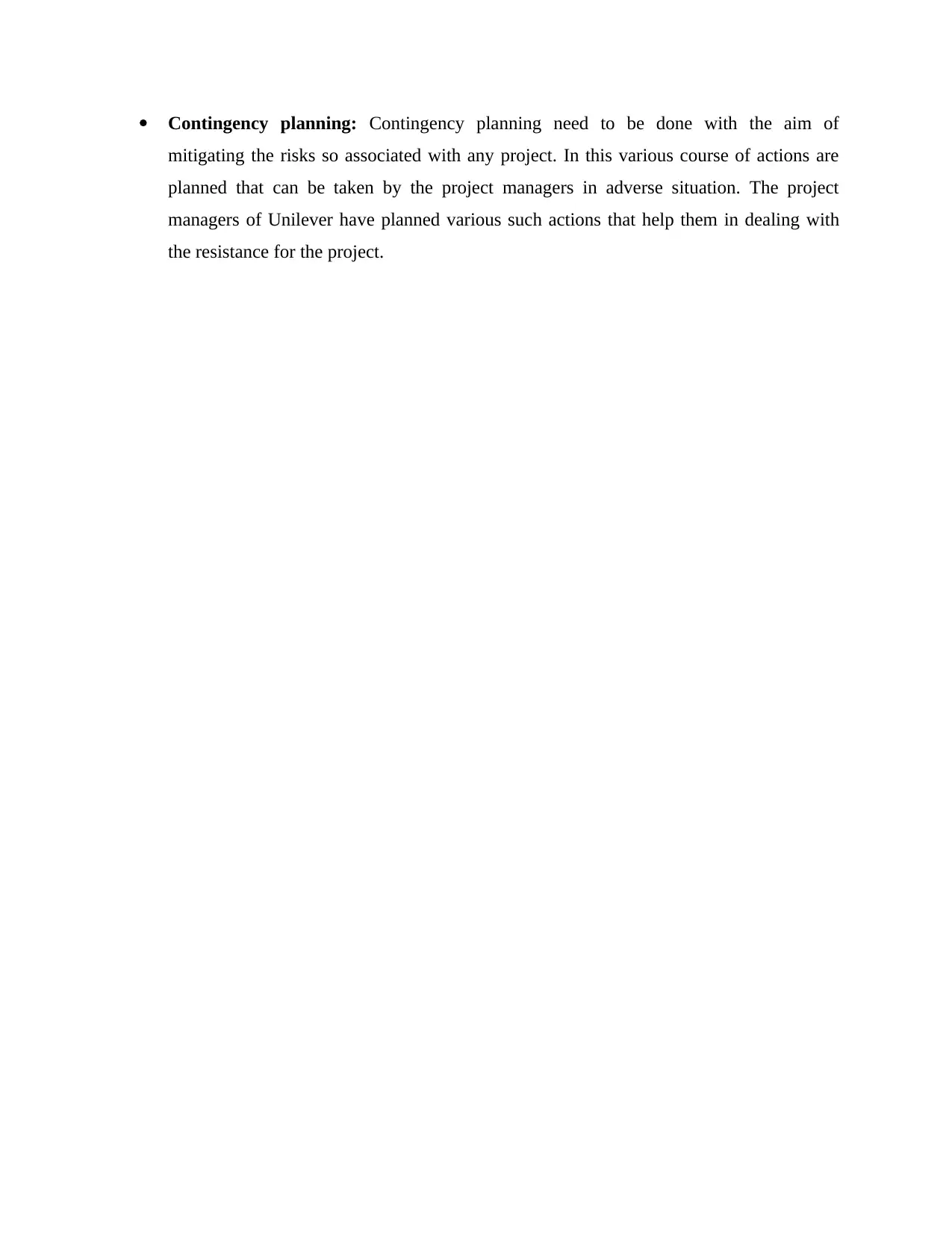
Contingency planning: Contingency planning need to be done with the aim of
mitigating the risks so associated with any project. In this various course of actions are
planned that can be taken by the project managers in adverse situation. The project
managers of Unilever have planned various such actions that help them in dealing with
the resistance for the project.
mitigating the risks so associated with any project. In this various course of actions are
planned that can be taken by the project managers in adverse situation. The project
managers of Unilever have planned various such actions that help them in dealing with
the resistance for the project.
⊘ This is a preview!⊘
Do you want full access?
Subscribe today to unlock all pages.

Trusted by 1+ million students worldwide
1 out of 14
Related Documents
Your All-in-One AI-Powered Toolkit for Academic Success.
+13062052269
info@desklib.com
Available 24*7 on WhatsApp / Email
![[object Object]](/_next/static/media/star-bottom.7253800d.svg)
Unlock your academic potential
Copyright © 2020–2025 A2Z Services. All Rights Reserved. Developed and managed by ZUCOL.





